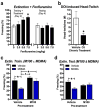Inhibition of serotonin transporters disrupts the enhancement of fear memory extinction by 3,4-methylenedioxymethamphetamine (MDMA)
- PMID: 28741031
- PMCID: PMC5693755
- DOI: 10.1007/s00213-017-4684-8
Inhibition of serotonin transporters disrupts the enhancement of fear memory extinction by 3,4-methylenedioxymethamphetamine (MDMA)
Abstract
Rationale: 3,4-Methylenedioxymethamphetamine (MDMA) persistently improves symptoms of post-traumatic stress disorder (PTSD) when combined with psychotherapy. Studies in rodents suggest that these effects can be attributed to enhancement of fear memory extinction. Therefore, MDMA may improve the effects of exposure-based therapy for PTSD, particularly in treatment-resistant patients. However, given MDMA's broad pharmacological profile, further investigation is warranted before moving to a complex clinical population.
Objectives: We aimed to inform clinical research by providing a translational model of MDMA's effect, and elucidating monoaminergic mechanisms through which MDMA enhances fear extinction.
Methods: We explored the importance of monoamine transporters targeted by MDMA to fear memory extinction, as measured by reductions in conditioned freezing and fear-potentiated startle (FPS) in mice. Mice were treated with selective inhibitors of individual monoamine transporters prior to combined MDMA treatment and fear extinction training.
Results: MDMA enhanced the lasting extinction of FPS. Acute and chronic treatment with a 5-HT transporter (5-HTT) inhibitor blocked MDMA's effect on fear memory extinction. Acute inhibition of dopamine (DA) and norepinephrine (NE) transporters had no effect. 5-HT release alone did not enhance extinction. Blockade of MDMA's effect by 5-HTT inhibition also downregulated 5-HT2A-mediated behavior, and 5-HT2A antagonism disrupted MDMA's effect on extinction.
Conclusions: We validate enhancement of fear memory extinction by MDMA in a translational behavioral model, and reveal the importance of 5-HTT and 5-HT2A receptors to this effect. These observations support future clinical research of MDMA as an adjunct to exposure therapy, and provide important pharmacological considerations for clinical use in a population frequently treated with 5-HTT inhibitors.
Keywords: Fear extinction; Fear-potentiated startle; MDMA; Monoamines; Serotonin.
Figures





References
-
- Asan E, Steinke M, Lesch KP. Serotonergic innervation of the amygdala: targets, receptors, and implications for stress and anxiety. Histochemistry and cell biology. 2013;139:785–813. - PubMed
-
- Battaglia G, Brooks BP, Kulsakdinun C, De Souza EB. Pharmacologic profile of MDMA (3,4-methylenedioxymethamphetamine) at various brain recognition sites. European journal of pharmacology. 1988;149:159–63. - PubMed
MeSH terms
Substances
Grants and funding
LinkOut - more resources
Full Text Sources
Other Literature Sources
Medical
Miscellaneous

